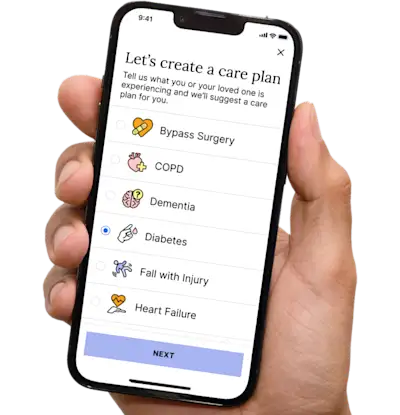Caregiving Challenges, When is it Time to Move?
Your loved one has indicators that it may be appropriate to move them to a safer, more supportive place of residence.
Get insurance benefits, legal documents, and medical records in one place

Helpful Highlights
People not only put off making a necessary move, but they even put off planning for a move. Start planning now, even if you never need it.
Engage in thoughtful discussion and meaningful planning with your loved one by familiarizing yourself with their health conditions and finding out their needs and wants.
Observe for important indicators that their independence may be declining.
Exhaust alternatives first, as feasible - engaging family and friends, making home modifications, and hiring in-home help and personal care.
The decision to move your loved one is often delayed because of the physical and emotional demands on you both. Each family will have its own reasons for wanting (or not wanting) to take such a step. Making a decision that is best for your loved one, and making that decision with your loved one, can be difficult and is never decided in a day. Try to learn as much as you can about the possible options and discuss them together.
Older adults and their families have some options when it comes to deciding where to live, but these choices can be limited by factors such as illness, ability to perform ADLs (eating, bathing, toileting, dressing, transferring, and walking), financial resources, availability, and personal preferences.
Remain at home with modifications, addition of assistive equipment and monitoring, and/or in-home help from home health aides.
Locate live-in help such as a college student or young adult that can "buddy" with your loved one. (This is becoming more popular as young people need places to live and older people need household help.)
Move in with you and your family, or move in with other family members.
Move to a retirement community, an independent living facility (ILF), or an assisted living facility (ALF).
Planning too far ahead is hard, foremost because it's likely that you and your loved one can't imagine them living anywhere but where they live now, though also because you never know how needs might change. The first step is to think about the kinds of help wanted or needed in the future. Where are you seeing a decline in their abilities? Sometimes the decline occurs in their own caregiving ability - maybe they are struggling to take care of a spouse who has needs and both are worse for it.
One way to begin planning is to look at any chronic illnesses your loved one lives with (diabetes, emphysema, heart failure, and so on). Talk with the primary care provider about how these health problems could make it hard for someone to get around and take care of him- or herself in the future.
When your loved one needs more assistance with ADLs and IADLs (see below) than you can provide, this might be a reason to discuss moving, especially if their safety is at risk.
IADLs (Instrumental Activities of Daily Living) are tasks that are a necessary part of everyday life. They require thought and planning. Examples are managing finances, managing transportation, shopping and meal preparation, housecleaning and home maintenance, managing communication, and obtaining medications.
ADLs (Activities of Daily Living) are more basic personal care tasks that are essential to independent living, health, and well-being. Examples are bathing/showering, dressing and undressing, grooming and hygiene, transferring, walking, toileting, eating, and taking medications.
When your loved one does not want to do or cannot do these things for themselves, or when there is not enough manpower or finances to support their needs in their current home, a move to a different residence may ease their burden - and yours.
Take into consideration that the family may live too far away to be able to provide regular assistance and supervision. Or maybe everything required with home ownership and maintenance is undesirable or overwhelming to them anymore. Or perhaps your loved one is lonely and would like to socialize with people their own age and with similar life experiences. And perhaps a change in their health simply requires more assistance than can be provided in their current home.
A move could be the best decision for many reasons, and everyone’s situation is different, but it may be time to move if:
Your loved one does not want to or cannot maintain and repair their home
Your loved one would like more activities, socialization, and less isolation
Your loved one needs regular care and/or supervision
The family is worried about their welfare and safety
Understand that many older adults fear being "put into a home" and forgotten about by their loved ones, or they fear how they will be treated in a facility. This may be an irrational fear, but it is very real to them. And you may feel guilt for having to move your loved one and not being able to take care of them yourself. Again, this may be an irrational response, but it is very real to you. It is because of these feelings and more that discussion and planning need to happen early, rather than in response to a crisis and immediate need.
Come to an agreement and plan that will work for everyone. Start by asking your loved one what would need to happen to them to consider moving. (And try not to accept "only after I'm dead" as a meaningful response!) Possibilities include:
I am not taking care of myself or my home (try to get specific).
I do not remember to take my medications even with a pill planner, or don't know how to take them correctly.
I could not get out of my home if an emergency happened, such as a fire.
I cannot manage IADLs and ADLs (again, get specific), even with in-home help.
People stop coming to visit or I can no longer get out without a lot of help.
Typically, the first move may be from home to an ILF or ALF. The best plan, based on your loved one’s status, is to move to a location where they can remain for years.
No content in this app, regardless of date, should ever be used as a substitute for direct medical advice from your doctor or other qualified clinician.
Get more support and guidance on insurance benefits, medical records and legal forms.
Helpful brings together your insurance benefits, legal documents, and medical records in one personalized place — so you always know what you have, and never have to search again.

Technology for Health Tasks. Mental Health for the Tough Stuff.
Helpful connects your medical records, insurance, and caregiving tasks automatically. And when you need more than logistics, a therapist is here to guide you.
In-Network and Covered
For Individuals, Couples and Families
HIPAA Compliant, Data Stays Private


Healthcare Tasks Simplified

From syncing records to spotting drug interactions, Helpful does the heavy lifting, turning complex health info into clear tasks and showing you benefits you can actually use, giving you clarity and control over your care.

In-Network Mental Health

Our licensed therapists are here to support you and your loved ones through stress, burnout, and life’s hardest moments, with an inclusive, compassionate approach that works with most insurance plans.

Create Legal Documents

Plan ahead by creating will, trusts, advance directives and more, that ensure your wishes are honored in the event you can’t speak for yourself -with Helpful guiding you every step of the way.